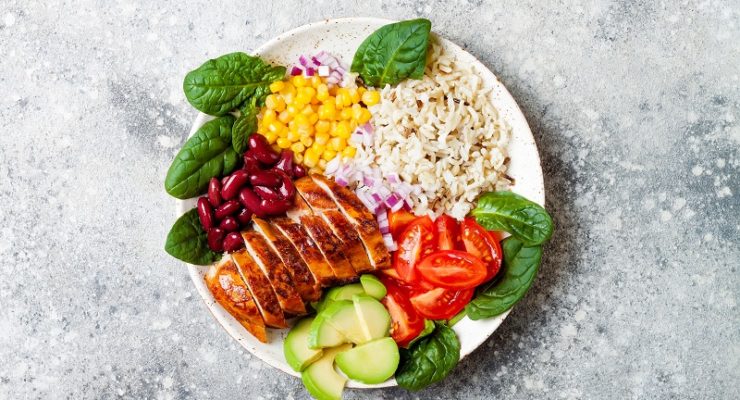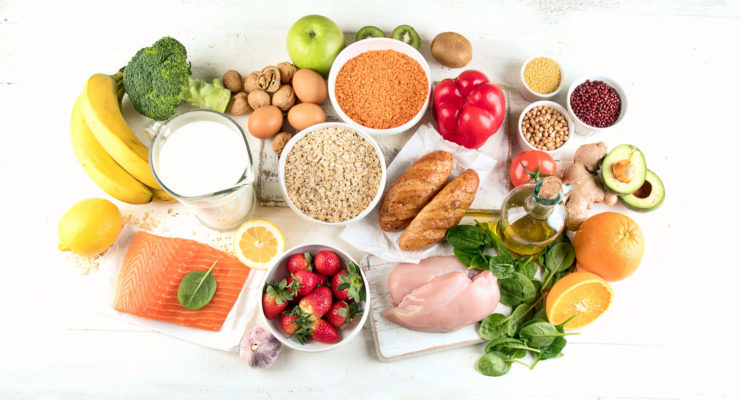How to Build the Best Power Bowl Ever
When our meals are balanced, we’re healthier. By including enough fruits and vegetables on our plate, we reduce our risk of heart disease, obesity, diabetes and cancer, according to the Centers for Disease Control and Prevention (CDC). When we fill up our bowl with adequate lean protein, we’re able to power through the day and are less likely to snack on high calorie foods later on. By consuming enough good fats, we can decrease our risk of cardiovascular problems and build healthy cell membranes and nerves, says Harvard Health. According to Healthline, selecting enough good carbs that are high in fiber can support a healthy gut and decrease cholesterol levels. Balanced nutrition can even help with our mental well-being, says ScienceDaily.
The problem is that most Americans don’t get everything they need on their plate. According to the United States Department of Agriculture (USDA), the average person only eats about one and half cups of vegetables per day, compared to the two to three cups they should be getting. We also eat too many refined grains and not enough fiber-rich whole grains, says the Office of Disease Prevention and Health Promotion. The American Diet also contains plenty of protein and fat. However, the protein typically isn’t lean and too many of the fats are saturated. In addition to unbalanced meals, the Morbidity and Mortality Weekly Report explains that an increase in total calories has contributed to our ballooning obesity (with most coming predominantly from carbs).
There’s one easy way to make balanced meals that doesn’t require a culinary degree, power bowls. These nutrition-packed meals combine the right portions of protein, carbs, vegetables and fats to keep your nutrition, health and waistline on point. They also don’t skimp on flavor or variety: By changing up the mix, you can enjoy bowls that incorporate your favorite flavors. Try out this breakfast Sweet Potato Hash Bowl or enjoy Asian flavors for lunch with this Asian Edamame Power Bowl. You can even get a balanced meal that’s plant-based with our Veggie Power Bowl.
Use your creativity to build your own healthy power bowl with what you have on hand. It’s easy! Just plug some of your favorite foods into this formula to make your own perfectly portioned, fast casual-style power bowl. To help you get started, we’ve made a sample bowl so that you can follow along.
Make the best power bowl ever with these five simple steps:
1. Start with a handful of carbs.

Yes, we literally mean a handful. In a study, published in the European Journal of Clinical Nutrition, participants incorrectly guessed portion sizes about fifty percent of the time. Researchers explain, “Over-reporting was typical for cereals in both genders and for snacks, vegetables and fruit in women.”
Your solution to this serving size struggle is at the end of your arm: Choose a grain or pasta to start your power bowl, such as brown rice, whole wheat pasta, quinoa or another favorite. Put a cupped handful (about a half-cup serving or around the size of a tennis ball) into the base of your bowl.
For our sample bowl, we’ll start with a serving of high fiber brown rice.
2. Add a palm-sized piece of protein.

Your hand helps here, too! Assuming you’re not sporting world record mitts, the size of your palm will equal just about three ounces of lean beef, chicken or fish. For most of us, that’s enough protein for a serving depending on the meal category. Check out your Nutrisystem Flex Meal guidelines to ensure you’re getting enough. Prefer a vegetarian protein? For choices like tofu or seitan, go back to that cupped hand—a half-cup of these ingredients is a great source of plant-based protein.
For our sample bowl, we’ll top our brown rice with a palm-sized piece of chicken breast that’s cooked in oil (see below) and diced into cubes.
Need some help with PowerFuels and SmartCarbs? Click the link below for everything you need to know!
3. Toss in a few fists of vegetables.

Load up your bowl with non-starchy vegetables for a filling meal that’s packed with nutrition. On Nutrisystem, members are encouraged to eat at least four servings of non-starchy vegetables per day. Adding veggies to your power bowl will give it heart disease-fighting benefits, belly-filling fiber and other vitamins you need. In addition to superfood powers, it will also provide crunch, sweetness and more deliciousness.
How much to add? Your fist is about the size of one serving of vegetables. Go for at least two in your power bowl to get a good start on that four-serving goal. If you’re not sure what qualifies as a non-starchy veggie, click here to learn more. >
For our sample bowl, we’re going for three servings and tossing in a fistful of chopped broccoli florets, another of diced sweet red bell pepper and a big handful of chopped Romaine lettuce.
4. Try to cook with a fingertip of oil.

The calories in cooking oil can add up fast. Want a boiled potato? It’s 97 calories. Turn those potatoes into fries with some oil and your side dish just jumped over 300 calories. Keep your cooking oil in check by sticking to a single serving, a teaspoon. If your measuring spoons aren’t nearby, use your fingertip as a guide for a teaspoon-ish of oil. This will be enough to sauté the chicken breast used for our sample bowl.
5. Thumbs up for something fancy or fun.

Dress your bowl with something delicious—a favorite sauce, dressing or some shredded cheese. To keep your portions in check, check out your thumb: A thumb-size portion will be about a tablespoon, perfect for keeping fatty dressings filling your bowl with flavor but not crushing it with calories.
We’ll finish our sample bowl with a tablespoon of a lemon vinaigrette for a warm, delicious power bowl of brown rice, chicken, broccoli, red pepper and romaine, seasoned with salt and freshly cracked pepper.
With Nutrisystem, you can enjoy delicious meals that are perfectly portioned for weight loss. Even better, we deliver them directly to your door! Click here to get started >
The post How to Build the Best Power Bowl Ever appeared first on The Leaf.
source https://leaf.nutrisystem.com/power-bowl-guide/




Comments
Post a Comment